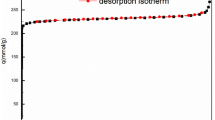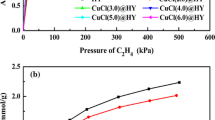Abstract
In this work, we report thermodynamically consistent adsorption data of H2/N2 and H2/CO2 mixtures on Cu-BTC at 297 K and pressures up to 1000 kPa. The measurements were performed on a recirculation volumetric set-up. The experimental (excess) data was converted into absolute adsorption by using the pore volume of the material, measured by Nitrogen at 77 K. From these data, the absolute and the excess surface phase properties (uptake, selectivity, surface potential) were compared. The results show that the absolute selectivity is lower than the excess selectivity in the two mixtures. Furthermore, an analysis of models’ performances in the two mixtures adsorption shows that the extended Langmuir and Toth models predict fairly the excess selectivity whereas IAST is suitable to describe the absolute selectivity.












Similar content being viewed by others
References
Brandani, S., Mangano, E., Sarkisov, L.: Net, excess and absolute adsorption and adsorption of helium. Adsorption 22(2), 261–276 (2016)
Brandani, S., Mangano, E., Luberti, M.: Net, excess and absolute adsorption in mixed gas adsorption. Adsorption 23(4), 569–576 (2017)
Gumma, S., Talu, O.: Gibbs dividing surface and helium adsorption. Adsorption 9, 17–28 (2003)
Hughes, I.G., Hase, T.P.A.: Measurements and their Uncertainties: a practical guide to modern error analysis. Oxford University Press Inc., New York (2010)
Jaroniec, M., Töth, J.: Adsorption of gas mixtures on heterogeneous solid surfaces: I. Extension of Tóth isotherm on adsorption from gas mixtures. Colloid Polym. Sci. 254(7), 643–649 (1976)
Keller, J.U., Göbel, M.U.: Oscillometric—volumetric measurements of pure gas adsorption equilibria devoid of the non-adsorption of helium hypothesis. Adsorpt. Sci. Technol. 33(9), 793–818 (2015)
Keller, J.U., Goebel, M.U., Seeger, T.: Oscillometric–gravimetric measurements of pure gas adsorption equilibria without the non-adsorption of helium hypothesis. Adsorption 23(6), 753–766 (2017)
Keskin, S.: Molecular simulations for adsorption-based CO2 separation using metal organic frameworks. In: Zafar, F., Sharmin, E. (eds.) Metal-Organic Frameworks. InTech, Rijeka (2016)
Kloutse, F.A., Hourri, A., Natarajan, S., Benard, P., Chahine, R.: Experimental benchmark data of CH4, CO2 and N2 binary and ternary mixtures adsorption on MOF-5. Sep. Purif. Technol. 197, 228–236 (2018a)
Kloutse, F.A., Hourri, A., Natarajan, S., Benard, P., Chahine, R.: Hydrogen separation by adsorption: experiments and modelling of H2-N2-CO2 and H2-CH4-CO2 mixtures adsorption on CuBTC and MOF-5. Microporous Mesoporous Mater. 271, 175–185 (2018b)
Li, J.-R., Kuppler, R.J., Zhou, H.-C.: Selective gas adsorption and separation in metal-organic frameworks. Chem. Soc. Rev. 38(5), 1477–1504 (2009)
Li, B., Wang, H., Chen, B.: Microporous metal–organic frameworks for gas separation. Chemistry 9(6), 1474–1498 (2014)
Liang, Z., Marshall, M., Chaffee, A.L.: CO2 adsorption-based separation by metal organic framework (Cu-BTC) versus zeolite (13X). Energy Fuels 23(5), 2785–2789 (2009)
Liu, D., Zhong, C.: Understanding gas separation in metal-organic frameworks using computer modeling. J. Mater. Chem. 20(46), 10308–10318 (2010)
Myers, A.L.: Thermodynamics of adsorption in porous materials. AIChE J. 48(1), 145–160 (2002)
Myers, A.L., Monson, P.A.: Physical adsorption of gases: the case for absolute adsorption as the basis for thermodynamic analysis. Adsorption 20(4), 591–622 (2014)
Myers, A., Prausnitz, J.M.: Thermodynamics of mixed-gas adsorption. AIChE J. 11(1), 121–127 (1965)
Panella, B., Hirscher, M., Putter, H., Muller, U.: Hydrogen adsorption in metal–organic frameworks: Cu-MOFs and Zn-MOFs compared. Adv Funct Mater 16(4), 520–524 (2006)
Rao, M.B., Sircar, S.: Thermodynamic consistency for binary gas adsorption equilibria. Langmuir 15(21), 7258–7267 (1999)
Ruthven, D.M., Farooq, S., Knaebel, K.S.: Pressure Swing Adsorption, vol. 480. VCH Publishers, New York (1994)
Silva, B., Solomon, I., Ribeiro, A.M., Lee, U.H., Hwang, Y.K., Chang, J.-S., Loureiro, J.M., Rodrigues, A.E.: H2 purification by pressure swing adsorption using CuBTC. Sep Purif Technol 118(Supplement C), 744–756 (2013)
Siperstein, F.R., Myers, A.L.: Mixed-gas adsorption. AIChE J. 47(5), 1141–1159 (2001)
Sircar, S.: Excess properties and thermodynamics of multicomponent gas adsorption. J Chem Soc Faraday Trans 81(7), 1527–1540 (1985)
Sircar, S.: Gibbsian surface excess for gas adsorptionrevisited. Ind. Eng. Chem. Res. 38(10), 3670–3682 (1999)
Sircar, S.: Basic research needs for design of adsorptive gas separation processes. Ind. Eng. Chem. Res. 45(16), 5435–5448 (2006)
Sircar, S.: Comments on the artificiality of actual amount adsorbed. Ind. Eng. Chem. Res. 57(19), 6766–6773 (2018)
Talbot, J.: Analysis of adsorption selectivity in a one-dimensional model system. AIChE J. 43(10), 2471–2478 (1997)
Talu, O.: Needs, status, techniques and problems with binary gas adsorption experiments. Adv. Colloid Interface Sci. 76–77, 227–269 (1998)
Talu, O.: Net adsorption of gas/vapor mixtures in microporous solids. J. Phys. Chem. C 117(25), 13059–13071 (2013)
Thomas, W.J., Crittenden, B.: 2—adsorbents. In: Adsorption Technology & Design, pp 8–30. Butterworth-Heinemann, Oxford (1998)
Yang, R.T.: Chapter 3—equilibrium adsorption of gas mixtures. In: Gas Separation by Adsorption Processes, pp. 49–100. Butterworth-Heinemann (1987c)
Yang, R.T.: Chapter 2—adsorbents and adsorption isotherms. In: Gas Separation by Adsorption Processes, pp. 9–48. Butterworth-Heinemann (1987b)
Yang, R.T.: Chapter 1—introductory remarks. In: Gas Separation by Adsorption Processes, pp. 1–8. Butterworth-Heinemann (1987a)
Author information
Authors and Affiliations
Corresponding author
Additional information
Publisher's Note
Springer Nature remains neutral with regard to jurisdictional claims in published maps and institutional affiliations.
Rights and permissions
About this article
Cite this article
Kloutse, F.A., Hourri, A., Natarajan, S. et al. Systematic study of the excess and the absolute adsorption of N2/H2 and CO2/H2 mixtures on Cu-BTC. Adsorption 25, 941–950 (2019). https://doi.org/10.1007/s10450-019-00124-3
Received:
Revised:
Accepted:
Published:
Issue Date:
DOI: https://doi.org/10.1007/s10450-019-00124-3




